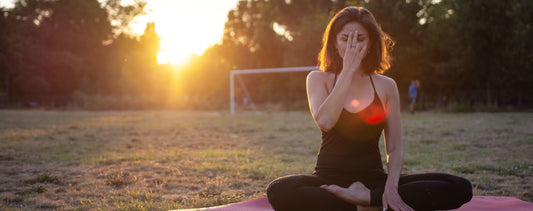Transitioning from our busy days into the evening can feel challenging for many. Even though the day is finished, the chatter of the mind and stress we carry often continues. This can make it hard to relax and especially hard to fall asleep. It is essential that we take measures to intentionally wind down the day and prepare the body for rest.
A calming evening practice can help communicate to the body and mind that it is time to relax and end the day. Pranayama is a powerful way to calm both the mind and body for deep rest and a full night of sleep. Practice these soothing pranayama techniques next time it feels like your mind won’t stop running.
After completing any of these pranayama techniques, I invite you to sit in meditation for some time after, allowing the effects of the practice to settle and further relax the body and mind.
4-7-8 breath is a profoundly relaxing pranayama technique for reducing anxiety and calming a running mind. The breath pattern is simple and deeply soothing, invoking a sense of stillness and grounding to prepare for sleep.
To practice this breathing style, find a comfortable seat and a place where you will not be disturbed. Take a few normal breaths to settle into the body. Then begin by inhaling for the count of four, holding at the top for a count of seven, then exhaling for a count of eight. Continue this pattern for a few minutes to start.
You can either finish here or take a brief break before resuming the breath pattern for a few minutes once more. This is also a great style of breath to practice during times of stress when you need a quick and effective way to calm the mind.
Box breathing involves Sama Vritti breath or equal length breath with retention at the top of the inhale and bottom of the exhale. Get comfortable, then breathe in for the count of four. Hold at the top for four before exhaling for the same count and holding at the bottom.
Continue for a few rounds like this, determining whether or not four is a comfortable count for the breath, making it longer or shorter as needed. Practice this breath pattern for a couple of minutes. Either finish here or take a brief break before moving into another round, increasing the amount of time you practice as you get more comfortable.
Most of us breathe shallowly and from our chests without even realizing it. This kind of breath is not conducive to calming the mind and can exacerbate tension in our system. Breathing from our diaphragm communicates to our bodies that we are safe, promotes deep relaxation, and even activates the parasympathetic nervous system. Lying in crocodile pose to practice belly breathing helps us refine the breath and achieve a deep state of calm.
Come to lie down on your belly. Create a pillow with your palms to either rest your forehead on. Allow your toes to face out and heels to fall in. You can place a block on the lower-middle back if you have one. Begin to take slow, deep breaths into the lower belly. Feel your stomach expand and press into the ground as you feel the block rise and fall with the breath.
Continue to breathe from the diaphragm, letting your body heavy with every exhale. As you breathe, you can add a count to your breath, creating equal length inhales and exhales at a count that feels good for you. Continue this pattern for 5-10 minutes, allowing yourself time to transition out and back into your day when you finish.
Three-part breath is a simple and effective breath practice. The inhale is split into two parts, breathing first into your belly, then into your chest, then exhaling. Try to practice slowly and intentionally, inhaling into the belly, up into the chest, then effortlessly exhaling. Practice this breath pattern for around five minutes, softening deeper with every exhale and being fully present with the breath.
Find support for restful sleep with Pranayama for Sleep, a four-part series with Dr. Amit Anand, available now in the Chopra App.
A calming evening practice can help communicate to the body and mind that it is time to relax and end the day. Pranayama is a powerful way to calm both the mind and body for deep rest and a full night of sleep. Practice these soothing pranayama techniques next time it feels like your mind won’t stop running.
After completing any of these pranayama techniques, I invite you to sit in meditation for some time after, allowing the effects of the practice to settle and further relax the body and mind.
4-7-8 Breath
4-7-8 breath is a profoundly relaxing pranayama technique for reducing anxiety and calming a running mind. The breath pattern is simple and deeply soothing, invoking a sense of stillness and grounding to prepare for sleep.
To practice this breathing style, find a comfortable seat and a place where you will not be disturbed. Take a few normal breaths to settle into the body. Then begin by inhaling for the count of four, holding at the top for a count of seven, then exhaling for a count of eight. Continue this pattern for a few minutes to start.
You can either finish here or take a brief break before resuming the breath pattern for a few minutes once more. This is also a great style of breath to practice during times of stress when you need a quick and effective way to calm the mind.
Box Breathing
Box breathing involves Sama Vritti breath or equal length breath with retention at the top of the inhale and bottom of the exhale. Get comfortable, then breathe in for the count of four. Hold at the top for four before exhaling for the same count and holding at the bottom.
Continue for a few rounds like this, determining whether or not four is a comfortable count for the breath, making it longer or shorter as needed. Practice this breath pattern for a couple of minutes. Either finish here or take a brief break before moving into another round, increasing the amount of time you practice as you get more comfortable.
Crocodile Pose with Belly Breaths
Most of us breathe shallowly and from our chests without even realizing it. This kind of breath is not conducive to calming the mind and can exacerbate tension in our system. Breathing from our diaphragm communicates to our bodies that we are safe, promotes deep relaxation, and even activates the parasympathetic nervous system. Lying in crocodile pose to practice belly breathing helps us refine the breath and achieve a deep state of calm.
Come to lie down on your belly. Create a pillow with your palms to either rest your forehead on. Allow your toes to face out and heels to fall in. You can place a block on the lower-middle back if you have one. Begin to take slow, deep breaths into the lower belly. Feel your stomach expand and press into the ground as you feel the block rise and fall with the breath.
Continue to breathe from the diaphragm, letting your body heavy with every exhale. As you breathe, you can add a count to your breath, creating equal length inhales and exhales at a count that feels good for you. Continue this pattern for 5-10 minutes, allowing yourself time to transition out and back into your day when you finish.
Three-Part Breath
Three-part breath is a simple and effective breath practice. The inhale is split into two parts, breathing first into your belly, then into your chest, then exhaling. Try to practice slowly and intentionally, inhaling into the belly, up into the chest, then effortlessly exhaling. Practice this breath pattern for around five minutes, softening deeper with every exhale and being fully present with the breath.
Find support for restful sleep with Pranayama for Sleep, a four-part series with Dr. Amit Anand, available now in the Chopra App.






















